Tue 26 Jan 2021
A PI Mystery Movie by David Vineyard: BLOOD ORANGE (1953).
Posted by Steve under Mystery movies , Reviews[13] Comments

BLOOD ORANGE. Hammer Films, UK, 1953. Released in the US as Three Stops to Murder (Astor Pictures, 1953). Tom Conway, Mila Parély, Naomi Chance, Eric Pohlman, Andrew Osborn, Richard Wattis. Screenplay: Jan Read. Director: Terence Fisher. Currently available on YouTube (embedded below).
This low budget private eye mystery has a surprisingly decent plot going for it, though it never quite amounts to much, despite a good cast.
Far from Film Noir it’s more in a minor Peter Cheyney key as a designer fashion house in London is robbed of the jewels used by their models, jewels on loan from vaguely foreign Mr. Mercedes (Eric Pohlman, the voice of Blofield in the early Bonds and a noted character actor), whose personal investigator arrives at the same time as Inspector McLeod of the Yard (bespectacled Richard Wattis as an unlikely Scotland Yard Inspector).
That private detective is former FBI agent Tom Conway (and yes, Tom Conway plays Tom Conway in this one, no doubt in an attempt to connect in British viewers minds with his role as Tom Falcon in the Falcon series).
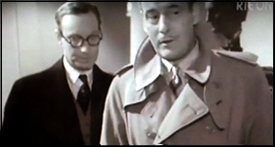
Helen Pascall (Mira Parély) owns the shop and is the designer, and blonde Gina (Naomi Chance) is her top model. Partner in the business is suave but broke clubman Captain Simpson, a ladies man (Andrew Osborn, and I suspect like me you will be hard put to see what the fuss is about though all the women are devoted to him).
At the shop the morning after the robbery is a middle aged peeress who claims when she was there the day before she saw two of her own jewels among the stones in Mercedes collection, and shortly after that Mercedes decides he doesn’t want Conway wasting time investigating the theft.
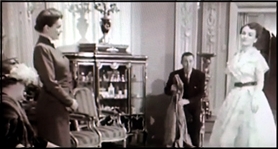
Conway, being American, and a private eye, doesn’t listen and is there the night of the upcoming show when one of the models plunges to her death wearing a blood orange gown designed by Helen Pascall from a defective railing Conway saved Simpson from earlier in the day.
When the woman who claimed to have seen her stolen jewels is murdered, also in a blood orange gown, after a visit by Conway it starts to look bad for him since bodies keep showing up at his feet, and when he finds a third model murdered again in a blood orange gown his relationship with reserved McLeod deteriorates further.
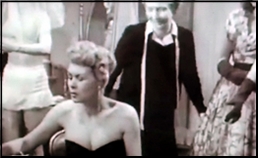
The police are suspicious of Mr. Mercedes (Pohlman is subdued, but not bad in the closest thing to a colorful performance in the film save for the killer who I won’t give away), and Conway is getting too close to something so his own boss ends up kidnapping him only for a police raid to throw Mercedes off. Mercedes fakes having a bomb and escapes, and Conway ends up in custody suspected of being in with Mercedes who it turns out was an international crook with a record across the world using his business interest in the fashion house to launder money and re-cut stolen jewels.
Then Mercedes is murdered, no doubt by an unsuspected partner, and Conway has to set a dangerous trap for a killer who has killed four people and who is willing to kill again.
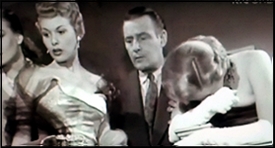
And in fairness, it is a pretty good trap, replete with a twist that I admit I did not see coming, and which made complete sense. In fact that is why I bothered to review this one at all.
Jealous lovers, criminal conspiracy, and a ruthless killer are the key ingredients here.
Admittedly Conway is tired by this point in his career (and drinking heavily), and while he still wears a trench coat well, he is not at his best. While there are some good scenes, especially between Conway and Naomi Chance as the sophisticated model Gina, there is nothing here that really clicks though the plot is more than serviceable for the short running time.
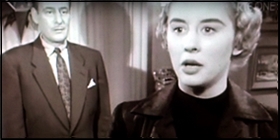
A tighter script, and less tired leading man, and a few touches of directorial flare would have boosted this immensely. As it is it kills an hour not unpleasantly even if it is instantly forgettable.
Probably the most interesting thing about this film is the studio where it was made, legendary Hammer, well before its horror days, and the director, Terence Fisher, who would helm many of the horror films that put Hammer on the map. Beyond that it is little more than a B programmer with a better than usual cast and some decent sets.
Frankly, while still a pro, Conway often looks as if he would prefer to sit down and have a drink, giving his brother George Sanders a run for bored and indifferent.
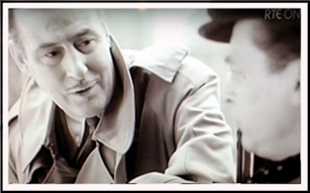
January 26th, 2021 at 3:11 pm
This appears to be the only time Tom Conway played a character with the same name as himself. He did follow this one up as another PI in the UK, a movie called Murder on Approval (aka Barbados Quest, 1955), but in that one the fellow’s name was Tom Martin.
January 26th, 2021 at 6:13 pm
I noticed in the poster a small notice proclaiming “It’s A British Production!”, accompanied by a drawing of a Union Jack.
We’re in the days of the Eady Plan, a British government initiative to boost the local film industry.
Part of the plan was to foster partnerships with American producers, who would supply stars or scripts (along with a stash of money) to get pictures made for cinemas on both sides of the ocean.
In this Hammer film, Tom Conway is IDed as an “American former FBI agent”, although both he and his brother George Sanders were Anglo-Russian: both born in St. Petersburg (aka Petrograd), left the Russian empire just ahead of the Bolsheviks.
George Sanders said in an interview that his (and Tom’s) mother was part of Russian nobility, while their British father “… came in the mail”.
I don’t know when (or if) the Sanders/Conway brothers ever took out American citizenship (correction welcomed as needed), but their film careers were almost completely in the USA, and they were considered “Hollywood stars” for their respective durations.
By the way, the leading lady here is Mila Parély, from France by way of Poland; check the film for confirmation.
January 26th, 2021 at 6:50 pm
Thanks for the correction on the leading lady’s name, Mike, and I’ve fixed it. And by the way, one way to get the accent right is to copy and paste it into the text of your comment, and I’ve surreptitiously done that as well.
And for more information on the Eady Plan, here’s a link to the appropriate Wikipedia page:
https://en.wikipedia.org/wiki/Eady_Levy
January 26th, 2021 at 7:25 pm
Sorry, I got the actress name off of IMDb and not the film itself, and frankly it could have been my eyes.
Sanders made his film debut in British films and appears as one of the gods in THE MAN WHO COULD WORK MIRACLES. I’ve seen him as a male ingenue in at least one other British film of that era. As far as I know Conway started in Hollywood though he may have had a stage career or minor roles in British films. A quick look at IMDb should tell that tale.
I’m trying to recall from Sanders bio if and when he took out American citizenship, but most of the Hollywood Raj did just because they lived here including a few with knighthoods (though technically there is no such thing as dual citizenship a number of actors had it for all practical purpose including American Douglas Fairbanks Jr). Considering British income tax at the time there wasn’t much reason not to.
Quite a few American actors went to the UK and Europe to make films in the fifties and the sixties including British actors like Ray Milland who had taken American citizenship and lived here (and ironically was cast as an American in British films).
Conway also starred in another British crime film as the Saint like Norman Conquest in a film of that name, based on the character created by Berkeley Gray (E. Sealy Brooks) also known by the nom de guerre 1066, a staple of the British pulp THRILLER where he competed with the Saint and the Toff among others.
Other “Russian” British actors were Peter Ustinov and Lawrence Harvey.
January 26th, 2021 at 10:37 pm
David, Ray Milland cast notably as an
American in Circle of Danger, a very well made non-mysterious mystery, that due to style and performance all around, Patrica Roc, Marius Goring, and others, is one I come back to from time to time.
January 27th, 2021 at 12:44 am
I’ve been looking for this for a couple of years, so thanks for bringing the YouTube link to my attention.
Very curious that Conway shares the name of his character – yet he’s clearly not playing himself.
Bob Baker and Monty Berman, who would later helm The Saint, tried to launch a series of B-films with Conway with ‘Barbados Quest’ and ‘Breakaway’, in which he played a Falcon analogue named Tom ‘Duke’ Martin. Both are reasonably good and I consider Conway to be underrated when playing a suave, twinkly-eyed gentleman sleuth.
January 27th, 2021 at 4:32 am
The actor playing the Detective-Inspector is Richard Wattis, not Watts.
January 27th, 2021 at 8:47 am
Right you are. I’ll fix that. Thanks!
January 27th, 2021 at 8:49 am
I find myself charmed by the naivete of film producers who assumed in those days that if you put Tom Conway, Brian Donlevey, or Zachary Scott in a British movie, that’d pack ’em in over here.
January 27th, 2021 at 10:57 am
Not naive, Dan, just cognizant of the fact a recognizable name would encourage theatre dates on the bottom half of a double bill.
January 27th, 2021 at 3:36 pm
Tom Conway’s character in the Falcon films was Tom Lawrence, not Tom Falcon.
January 27th, 2021 at 4:11 pm
Bingo.
January 27th, 2021 at 8:30 pm
Barry Lane,
CIRCLE OF DANGER is a favorite of mine too. Philip Macdonald script, and fine bit by Marius Goring.